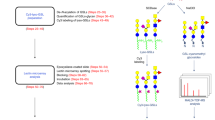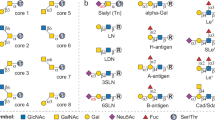Abstract
The oligosaccharide moieties of glycoproteins, glycolipids, proteoglycans and polysaccharides are highly diverse, the reason for this diversity is not yet understood. Neoglycolipid technology allows the generation of oligosaccharide probes with lipid tags from desired sources and is showing promise as a basis for oligosaccharide microarrays. Such microarrays would allow surveys of glycomes and proteomes to be carried out, which would enable the molecular definition of carbohydrate-recognition systems in whole organisms.
This is a preview of subscription content, access via your institution
Access options
Subscribe to this journal
Receive 12 print issues and online access
$189.00 per year
only $15.75 per issue
Buy this article
- Purchase on Springer Link
- Instant access to full article PDF
Prices may be subject to local taxes which are calculated during checkout



Similar content being viewed by others
References
Carbohydrates and Glycobiology. Science 291, 2337–2378 (2001).
Helenius, A. & Aebi, M. Intracellular functions of N-linked glycans. Science 291, 2364–2369 (2001).
Ghosh, P., Dahms, N. M. & Kornfeld, S. Mannose 6-phosphate receptors: new twists in the tale. Nature Rev. Mol. Cell Biol. 4, 202–212 (2003).
Crocker, P. R. Mammalian Carbohydrate Recognition Systems (Springer–Verlag, Berlin, 2001).
Karlsson, K. -A. Bacterium–host protein–carbohydrate interactions and pathogenicity. Biochem. Soc. Trans. 27, 471–474 (1999).
Watkins, W. M. Biochemistry and genetics of the ABO, Lewis and P blood group systems. Adv. Hum. Genet. 10, 1–136, 379–385 (1980).
Kabat, E. A. Philip Levine Award Lecture. Contributions of quantitative immunochemistry to knowledge of blood group A, B, H, Le, I and i antigens. Am. J. Clin. Pathol. 78, 281–292 (1982).
Esko, J. D. & Lindahl, U. Molecular diversity of heparan sulfate. J. Clin. Invest 108, 169–173 (2001).
Sugahara, K. et al. Recent advances in the structural biology of chondroitin sulfate and dermatan sulfate. Curr. Opin. Struct. Biol. 13, 612–620 (2003).
Hakomori, S. Glycosylation defining cancer malignancy: new wine in an old bottle. Proc. Natl Acad. Sci. USA 99, 10231–10233 (2002).
Feizi, T. Progress in deciphering the information content of the 'glycome'—a crescendo in the closing years of the millennium. Glycoconj. J. 17, 553–565 (2000).
Feizi, T. Demonstration by monoclonal antibodies that carbohydrate structures of glycoproteins and glycolipids are onco-developmental antigens. Nature 314, 53–57 (1985).
Drickamer, K. & Taylor, M. E. Identification of lectins from genomic sequence data. Methods Enzymol. 362, 560–567 (2003).
Feizi, T. Carbohydrate differentiation antigens: probable ligands for cell adhesion molecules. Trends Biochem. Sci. 16, 84–86 (1991).
Fukui, S., Feizi, T., Galustian, C., Lawson, A. M. & Chai, W. Oligosaccharide microarrays for high-throughput detection and specificity assignments of carbohydrate–protein interactions. Nature Biotechnol. 20, 1011–1017 (2002).
Feizi, T., Kabat, E. A., Vicari, G., Anderson, B. & Marsh, W. L. Immunochemical studies on blood groups XLIX. The I antigen complex: specificity differences among anti-I sera revealed by quantitative precipitin studies; partial structure of the I determinant specific for one anti-I serum. J. Immunol. 106, 1578–1592 (1971).
Gooi, H. C. et al. Stage specific embryonic antigen SSEA-1 involves α1–3 fucosylated type 2 blood group chains. Nature 292, 156–158 (1981).
Tang, P. W., Gooi, H. C., Hardy, M., Lee, Y. C. & Feizi, T. Novel approach to the study of the antigenicities and receptor functions of carbohydrate chains of glycoproteins. Biochem. Biophys. Res. Commun. 132, 474–480 (1985).
Feizi, T., Stoll, M. S., Yuen, C. -T., Chai, W. & Lawson, A. M. Neoglycolipids: probes of oligosaccharide structure, antigenicity and function. Methods Enzymol. 230, 484–519 (1994).
Stoll, M. S., Hounsell, E. F., Lawson, A. M., Chai, W. & Feizi, T. Microscale sequencing of O-linked oligosaccharides using mild periodate oxidation of alditols, coupling to phospholipid and TLC-MS analysis of the resulting neoglycolipids. Eur. J. Biochem. 189, 499–507 (1990).
Chai, W., Stoll, M. S., Cashmore, G. C. & Lawson, A. M. Specificity of mild periodate oxidation of oligosaccharide-alditols: relevance to the analysis of the core-branching pattern of O-linked glycoprotein oligosaccharides. Carbohydr. Res. 239, 107–115 (1993).
Chai, W. et al. High prevalence of 2-mono- and 2,6-di-substituted manol-terminating sequences among O-glycans released from brain glycopeptides by reductive alkaline hydrolysis. Eur. J. Biochem. 263, 879–888 (1999).
Srinivas, O., Mitra, N., Surolia, A. & Jayaraman, N. Photoswitchable multivalent sugar ligands: synthesis, isomerization, and lectin binding studies of azobenzene–glycopyranoside derivatives. J. Am. Chem. Soc. 124, 2124–2125 (2002).
Galustian, C. et al. Synergistic interactions of the two classes of ligand, sialyl-Lewisa/x fuco-oligosaccharides and short sulpho-motifs, with the P- and L- selectins: implications for therapeutic inhibitor designs. Immunology 105, 350–359 (2002).
Childs, R. A. et al. Neoglycolipids as probes of oligosaccharide recognition by recombinant and natural mannose-binding proteins of the rat and man. Biochem. J. 262, 131–138 (1989).
Mizuochi, T. et al. A library of oligosaccharide probes (neoglycolipids) from N-glycosylated proteins reveals that conglutinin binds to certain complex type as well as high-mannose type oligosaccharide chains. J. Biol. Chem. 264, 13834–13839 (1989).
Lawson, A. M. et al. High-sensitivity structural analyses of oligosaccharide probes (neoglycolipids) by liquid-secondary-ion mass spectrometry. Carbohydr. Res. 200, 47–57 (1990).
Chai, W., Stoll, M. S., Galustian, C., Lawson, A. M. & Feizi, T. Neoglycolipid technology: deciphering information content of glycome. Methods Enzymol. 362, 160–195 (2003).
Stoll, M. S., Mizuochi, T., Childs, R. A. & Feizi, T. Improved procedure for the construction of neoglycolipids having antigenic and lectin-binding activities from reducing oligosaccharides. Biochem. J. 256, 661–664 (1988).
Tang, P. W. & Feizi, T. Neoglycolipid micro-immunoassays applied to the oligosaccharides of human milk galactosyltransferase detect blood group related antigens on both O- and N-linked chains. Carbohydr. Res. 16, 133–143 (1987).
Tang, P. W., Scudder, P., Mehmet, H., Hounsell, E. F. & Feizi, T. Sulphate groups are involved in the antigenicity of keratan sulphate and mask i antigen expression on their poly-N-acetyllactosamine backbones. Eur. J. Biochem. 160, 537–545 (1986).
Solis, D. et al. Differential recognition by conglutinin and mannan-binding protein of N-glycans presented on neoglycolipids and glycoproteins with special reference to complement glycoprotein C3 and ribonuclease B. J. Biol. Chem. 269, 11555–11562 (1994).
Feizi, T. & Childs, R. A. Neoglycolipids: probes in structure/function assignments to oligosaccharides. Methods Enzymol. 242, 205–217 (1994).
Feizi, T., Lawson, A. M. & Chai, W. in Carbohydrate-based Drug Discovery: from the Laboratory to the Clinic. (Wong, C.-H. ed.) 747–760 (Wiley–VCH, Weinheim, 2003).
Osanai, T. et al. Two families of murine carbohydrate ligands for E-selectin. Biochem. Biophys. Res. Commun. 218, 610–615 (1996).
Galustian, G. et al. High and low affinity carbohydrate ligands revealed for murine SIGN-R1 by carbohydrate array and bell binding approaches, and differing specificities revealed for SIGN-R3 and langerin. Int. Immunol. 13, 853–866 (2004).
Feizi, T., Fazio, F., Chai, W. & Wong, C. H. Carbohydrate microarrays — a new set of technologies at the frontiers of glycomics. Curr. Opin. Struct. Biol. 13, 637–645 (2003).
Wang, D., Liu, S., Trummer, B. J., Deng, C. & Wang, A. Carbohydrate microarrays for the recognition of cross-reactive molecular markers of microbes and host cells. Nature Biotechnol. 20, 275–281 (2002).
Willats, W. G., Rasmussen, S. E., Kristensen, T., Mikkelsen, J. D. & Knox, J. P. Sugar-coated microarrays: a novel slide surface for the high-throughput analysis of glycans. Proteomics 2, 1666–1671 (2002).
Houseman, B. T. & Mrksich, M. Carbohydrate arrays for the evaluation of protein binding and enzymatic modification. Chem. Biol. 9, 443–454 (2002).
Park, S. & Shin, I. Fabrication of carbohydrate chips for studying protein–carbohydrate interactions. Angew. Chem. Int. Ed Engl. 41, 3180–3182 (2002).
Schwarz, M. et al. A new kind of carbohydrate array, its use for profiling anti-glycan antibodies, and the discovery of a novel human cellulose-binding antibody. Glycobiology 13, 749–754 (2003).
Fazio, F., Bryan, M. C., Blixt, O., Paulson, J. C. & Wong, C. H. Synthesis of sugar arrays in microtiter plate. J. Am. Chem. Soc. 124, 14397–14402 (2002).
Horan, N., Yan, L., Isobe, H., Whitesides, G. M. & Kahne, D. Nonstatistical binding of a protein to clustered carbohydrates. Proc. Natl Acad. Sci. USA 96, 11782–11786 (1999).
Leteux, C. et al. Influence of oligosaccharide presentation on the interactions of carbohydrate sequence-specific antibodies and the selectins. Observations with biotinylated oligosaccharides. J. Immunol. Methods 227, 109–119 (1999).
Zhu, H. & Snyder, M. Protein chip technology. Curr. Opin. Chem. Biol. 7, 55–63 (2003).
Plante, O. J., Palmacci, E. R. & Seeberger, P. H. Automated solid-phase synthesis of oligosaccharides. Science 291, 1523–1527 (2001).
Su, J. & Mrksich, M. Using mass spectrometry to characterize self-assembled monolayers presenting peptides, proteins, and carbohydrates. Angew. Chem. Int. Ed. Engl. 41, 4715–4718 (2002).
Groves, J. T., Wulfing, C. & Boxer, S. G. Electrical manipulation of glycan-phosphatidyl inositol-tethered proteins in planar supported bilayers. Biophys. J. 71, 2716–2723 (1996).
Stoll, M. S. et al. Fluorescent neoglycolipids: improved probes for oligosaccharide ligand discovery. Eur. J. Biochem. 267, 1795–1804 (2000).
Chou, D. K. H. et al. Structure of sulfated glucuronyl glycolipids in the nervous system reacting with HNK-1 antibody and some IgM paraproteins in neuropathy. J. Biol. Chem. 261, 11717–11725 (1986).
Acknowledgements
The authors are supported by the Medical Research Council. A. M. Lawson, R. A. Childs, M. S. Stoll and C. Galustian are acknowledged for critically reading this manuscript and we would also like to thank P. Crocker for stimulating discussions. This article is dedicated to the late Elvin A Kabat.
Author information
Authors and Affiliations
Corresponding author
Ethics declarations
Competing interests
The authors declare no competing financial interests.
Related links
Rights and permissions
About this article
Cite this article
Feizi, T., Chai, W. Oligosaccharide microarrays to decipher the glyco code. Nat Rev Mol Cell Biol 5, 582–588 (2004). https://doi.org/10.1038/nrm1428
Issue Date:
DOI: https://doi.org/10.1038/nrm1428
This article is cited by
-
Glycointeractions in bacterial pathogenesis
Nature Reviews Microbiology (2018)
-
Assignment by Negative-Ion Electrospray Tandem Mass Spectrometry of the Tetrasaccharide Backbones of Monosialylated Glycans Released from Bovine Brain Gangliosides
Journal of the American Society for Mass Spectrometry (2018)
-
Detecting Protein–Glycolipid Interactions Using Glycomicelles and CaR-ESI-MS
Journal of the American Society for Mass Spectrometry (2016)



